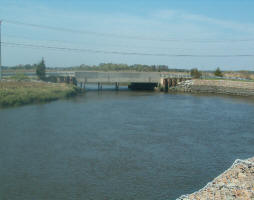 The Global Water Footprint of Key Crops
The Global Water Footprint of Key Crops
In order to grow the corn for your tortilla and the cotton for your T-shirt, farmers rely on freshwater from the world's river basins. Whether crops get watered by rain only or by irrigation as well, much of the water gets "consumed" through evaporation or transpiration, and so is no longer locally available.
The world’s population has surpassed seven billion, and that means more people rely on a finite amount offreshwater. The majority of that water is used in agriculture, and in this interactive we take a look at the impact of some of the most important crops produced for U.S. consumption.
In order to better understand water use and availability trends, scientists divide the Earth’s surface into river basins. This feature examines some of the river basins that are the most important from an agricultural perspective. In each basin, the primary source of water is precipitation. Rain and snow feeds the river and its tributaries, as well as groundwater, ponds, and lakes. Precipitation also adds moisture to the soil, and crops take up the moisture through their roots.
Most crops around the world are grown using only the soil moisture provided by rainfall. When this moisture is insufficient, farmers apply more water through irrigation. Some rain or irrigation water evaporates without benefiting the plant, while some transpires through the plant's tissues during photosynthesis and returns to the atmosphere. Water transformed into vapor in either of these ways is not available for use again in that local area, so in practical terms, it is lost or "consumed."
Different crops have different water needs, which vary with the climate in which they’re grown. Scientists at the University of Twente in the Netherlands have used modeling techniques to estimate the amount of water consumed by the various crops grown in river basins around the world. These are the data we use in this feature.
Fortunately, there are things farmers can do to reduce water consumption. Instead of flooding fields or sprinkling, they can use drip irrigation, which cuts evaporation losses by delivering water directly to the roots of plants. Such techniques are particularly important in dry regions, where heavy water consumption is depleting rivers and even causing some to dry up for portions of the year, as is currently the case with the Colorado, theIndus, the Murray, the Rio Grande, and others.
Learn more about global water footprints from the Water Footprint Network and about rivers and watersheds from The Nature Conservancy. Find out how much water is consumed to make everyday things and try our water footprint calculator to get a snapshot of your own consumption. Also check out our water wiz puzzle for kids.
| Contact information | n/a |
|---|---|
| News type | Inbrief |
| File link |
http://environment.nationalgeographic.com/environment/freshwater/global-water-footprint/?goback=.gde_1568157_member_134804764The |
| Source of information | Water Foot Print Network |
| Keyword(s) | Water Footprint |
| Subject(s) | AGRICULTURE , ENERGY , FINANCE-ECONOMY , HYDRAULICS - HYDROLOGY , INDUSTRY , INFORMATION - COMPUTER SCIENCES , MEASUREMENTS AND INSTRUMENTATION , METHTODOLOGY - STATISTICS - DECISION AID , NATURAL MEDIUM , POLICY-WATER POLICY AND WATER MANAGEMENT , TOOL TERMS , TOURISM - SPORT - HOBBIES , WATER DEMAND |
| Relation | http://www.emwis.net/topics/wfn |
| Geographical coverage | n/a |
| News date | 24/07/2012 |
| Working language(s) | ENGLISH |
 you are not logged in
you are not logged in





